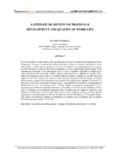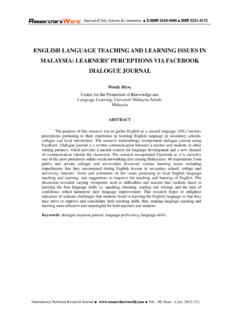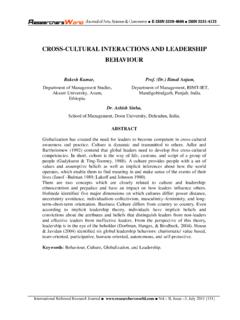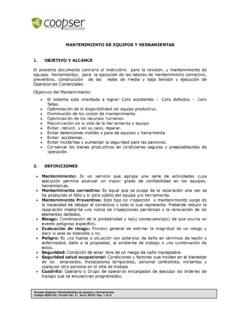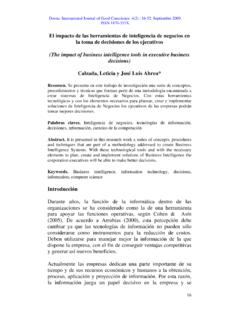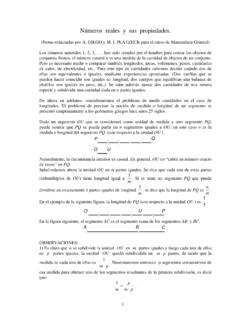Transcription of STRATEGIC ALLIANCE AND COMPETITIVENESS: …
1 - Journal of Arts Science & Commerce ISSN 2229-4686 International Refereed Research Journal Vol. II, Issue 1,January 2011 43 STRATEGIC ALLIANCE AND competitiveness : THEORETICAL FRAMEWORK Mohammed Belal Uddin PhD candidate in Accounting, Xiamen University, China & Lecturer in Accounting, Comilla University, Bangladesh Bilkis Akhter Lecturer, Dept. of Accounting & Information Systems University of Dhaka, Bangladesh ABSTRACT STRATEGIC alliances, which are cooperative strategies in which firms combine some of their resources to create competitive advantages, are the primary form of cooperative strategies. Research on STRATEGIC ALLIANCE in the past few decades has suggested that STRATEGIC ALLIANCE can enhance competitiveness . Whatever forms joint venture, equity based or nonequity based, STRATEGIC ALLIANCE assist in ensuring the economic value addition, multidimensional inter-firm network, and inter-organizational coordination.
2 In this paper we have tried to identify how STRATEGIC alliances enhance competitiveness and some factors which foster STRATEGIC alliances. Finally, we have identified some research gap that will help in conducting future research regarding STRATEGIC ALLIANCE issues. Keywords: STRATEGIC ALLIANCE , competitiveness , Joint Venture, Equity STRATEGIC ALLIANCE , and Nonequity STRATEGIC ALLIANCE . - Journal of Arts Science & Commerce ISSN 2229-4686 International Refereed Research Journal Vol. II, Issue 1,January 2011 44 INTRODUCTION STRATEGIC alliances are increasingly becoming popular day by day. To achieve competitive advantages firms combine their assets and capabilities in a cooperative policy that is termed as STRATEGIC ALLIANCE . STRATEGIC ALLIANCE is considered as an essential source of resource-sharing, learning, and thereby competitive advantage in the competitive business world.
3 Management of ALLIANCE and value creation to attain competitive advantage is very important in STRATEGIC ALLIANCE (Ireland et al, 2002). Formation of relational capital demands an integrative approach to manage the contemporary conflict, and firms get the opportunity of both at the same time. Thus, as linkages between them STRATEGIC ALLIANCE involve firms with some degree of exchange and sharing of resources and capabilities to co-develop or distribute goods or services (Kale et al, 2000). The achievement of competitive advantages is not possible by one firm itself because it does not possess required all resources and knowledge to be entrepreneurial and innovative in dynamic competitive markets. Interorganizational relationships create the opportunity to share the resources and capabilities of firms while working with partners to develop additional resources and capabilities as the function for new competitive advantages (Kuratko et al, 2001).
4 Unprecedented numbers of STRATEGIC alliances between firms are being formed each year. (These) STRATEGIC alliances are a logical and timely response to intense and rapid changes in economic activity, technology and globalization, all of which have cast many co operations into two competitive races: one for the world and another for the future (Doz and Hamel, 1998). Many firms, especially large global competitors establish multiple STRATEGIC alliances. General Motors alliances, for example, .. include a collaboration with Honda and internal combustion energies, with Toyota on advanced propulsion, with Renault on medium- and heavy-duty vans for Europe and, in , with AM general on the brand and distribution rights for the incomparable Hummer (Dallas Morning News, 2002). Lockheed Martin has forms more than 250 alliances with firms concentrating on the defense modernization by providing special attention on developing advanced technologies (Martin, 2002).
5 In general, STRATEGIC ALLIANCE success requires cooperative behavior from all partners. ALLIANCE success depends on several factors such as, actively involvement in problem solution, being trustworthy; to create value combining partners resources and capabilities, and persuasion among the partners for cooperation and coordination of activities in the cooperative organizational behavior. Conflict management practice and desire of achievement of competitive advantages in market also foster the ALLIANCE success (Tiessen and Linton, 2000). To identify an appropriate ALLIANCE structure requires more attention in the decision making process of ALLIANCE formation. Performance risk and relational risk are involved in choosing the partners to develop alliances. Overall objective is to minimize total risk and ensuring competitive advantages. A competitive advantages developed through a cooperative strategy often is called a collaborative or rational advantage (Das and Teng, 2001).
6 Competitive advantages significantly influence the firm s market place success. By using technological capabilities firms can ensure customer value and competitive advantage. (Afuah, 2002).Functional and educational experience provide an important dimension in competitive advantage. Rapid technological changes and the global economy are example of factors challenging firms to constantly upgrade current competitive advantages while they develop new ones to maintain STRATEGIC competitiveness (Geletkanycz, 2001). The objectives of this paper are, firstly, to review the STRATEGIC ALLIANCE literatures relating to competitiveness in the different forms of linkage networks. Secondly, identify the factors fostering the formation of alliances and empirical evidences. Finally, provide hypotheses and scope for future research regarding this issue. This paper, in the next section, discusses the STRATEGIC ALLIANCE and competiveness in different form of alliances.
7 A brief review of factors and empirical evidence regarding STRATEGIC ALLIANCE is provided in the third and fourth section respectively. The fifth section - Journal of Arts Science & Commerce ISSN 2229-4686 International Refereed Research Journal Vol. II, Issue 1,January 2011 45briefly discusses the hypotheses and research questions. The paper ends with concluding remarks. STRATEGIC Alliances and competitiveness Evidence suggests that complementary business level STRATEGIC ALLIANCE , especially vertical ones, have the greatest probability of creating a sustainable competitive advantage. More and more companies are entering into alliances to gain competitive advantages (Gari, 1999). STRATEGIC ALLIANCE designed to respond to competition and to reduce uncertainty can also create competitive advantages. However, these advantages tend to be more temporary those developed through complementary (both vertical and horizontal) STRATEGIC alliances.
8 The primary reason is that complementary alliances have a stronger focus on the creation of value compared to competition reducing and uncertainty reducing alliances, which tend to be formed to be respond to competitors actions rather than to attack competitors. The participants of corporate-level of strategies also can use the strategies to develop collaborate the knowledge for future success. Knowledge management is crucial for the firms to gain maximum value from this knowledge; firms should organize it and verify that it is always properly distributed to those involved with the formation and use of alliances. To successfully commercialize inventions, firms may therefore choose to cooperate with other organizations and integrate their knowledge and resources (Simonin, 1997). Firms also use cross-border alliances to help transform themselves or to better use their competitive advantages to take advantages of opportunities surfacing in the rapidly changing global economy.
9 For example, GEC, a based company seeks to move from a broadly focused group deriving much of its revenues from the defense budget to full range telecommunications and information system manufacturer. Networks have more than two components in relationships and they characterize the association of components in close relationships also in existing market-based relationship. Participants role playing, performance evaluation, profit-sharing and risk management become more complex because of high concentration of trust in network (Tomkins, 2001). A network cooperative strategy is particularly effective when it is formed by firms clustered together, as with Silicon Valley in California and Singapore s Silicon Island (Cohen and Fields, 1999). The STRATEGIC alliances can be mostly summarized into three dimensions: joint venture, equity STRATEGIC ALLIANCE , and nonequity STRATEGIC ALLIANCE .
10 This section reviews the literature on how the three dimensions of STRATEGIC ALLIANCE may contribute to competitiveness . Joint Venture When two or more firms form a legally independent firm to share their collaborative capabilities and resources to achieve competitive advantages in the market is termed as joint venture in the form of STRATEGIC ALLIANCE . Joint ventures are effecting in establishing long-term relationship and in transferring tacit knowledge. Because it cannot be codified, tacit knowledge is learned through experiences (Berman et al, 2002) such as those taking place when people from partner firms work together in joint venture. Expertise and experience in particular field foster the sustainable competitive advantage. Tacit knowledge is an important source of competitive advantage for many firms (Tiessen and Linton, 2000). In a joint venture endeavor generally participating firms share resources and participate in the operations management equally.
